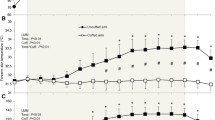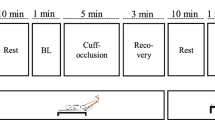Abstract
This study used cross-sectional and longitudinal training research designs to determine if (a) exercise hyperemia is enhanced in exercise-trained forearms and (b) sympathetic vasoconstriction of the trained forearm is attenuated (sympatholysis) during handgrip exercise. In the cross-sectional comparison, 10 rock climbers, 10 runners, 10 controls participated while the longitudinal training study examined vascular responsiveness in six untrained men before and after 6 weeks of handgrip training. Mean blood velocity, brachial artery diameter, heart rate, and systemic blood pressure were measured at rest, during a cold pressor test (CPT), dynamic handgrip exercise at 30% MVC with and without CPT, and during reactive hyperemia. During the resting CPT, forearm blood flow (FBF) decreased less (P < 0.05) in runners than in climbers, the decline being −6.30 + 30.05 and −34.3 + 20.54 during the last minute, respectively. During handgrip exercise, FBF and vascular conductance (VC) increased more (P < 0.05) in climbers than in runners and controls, the latter reaching 3.98 + 1.11, 2.22 + 0.88, and 2.75 + 1.06 ml min−1 mmHg−1, respectively. When a CPT was added during handgrip exercise, the reduction in FBF and VC was not different between the groups. Handgrip training increased (P < 0.05) forearm volume (5 + 3%) and MVC (25 + 29%), but did not affect FBF or VC during a CPT, with or without exercise. These data suggest that arm-trained athletes have greater exercise hyperemia. However, this training effect is not explained by sympatholysis and is not evident after 6 weeks of handgrip training in previously untrained subjects.






Similar content being viewed by others
References
Blandini F, Martignoni E, Sances E, Bono G, Nappi G (1995) Combined response of plasma and platelet catecholamines to different types of short-term stress. Life Sci 56:1113–1120
Clarkson P, Montgomery HE, Mullen JM, Donald AE, Powe AJ, Bull T, Jubb M, World M, Deanfield JE (1999) Exercise training enhances endothelial function in young men. J Am Coll Cardiol 33:1379–1385
Claytor RP, Cox RH, Howley ET, Lawler KA, Lawler JE (1988) Aerobic power and cardiovascular response to stress. J Appl Physiol 65:1416–1423
Correti MC, Anderson TJ, Benjamin EJ, Celermajer D, Charbonneau F, Creager MA, Deanfield J, Drexler H, Gerhard-Herman M, Herrington D, Vallance P, Vita J, Vogel R (2002) Guidelines for the ultrasound assessment of endothelial-dependent flow-mediated vasodilation of the brachial artery. J Am Coll Cardiol 39:257–265
DeSouza CA, Shapiro LF, Clevenger CM, Dinenno FA, Monahan KD, Tanaka H, Seals DR (2000) Regular aerobic exercise prevents and restores age-related declines in endothelium-dependent vasodilation in healthy men. Circulation 102:1351–1357
Dimmeler S, Zeiher AM (2003) Exercise and cardiovascular health: Get active to “AKTivate” your endothelial nitric oxide synthase. Circulation 107:3118–3120
Dinenno FA, Tanaka H, Stauffer BL, Seals DR (2001) Reductions in basal limb blood flow and vascular conductance with human ageing: role for augmented alpha-adrenergic vasoconstriction. J Physiol 536:977–983
Franke WD, Stephens GM, Schmid PG III (1998) Effects of intense exercise training on endothelium-dependent exercise-induced vasodilatation. Clin Physiol 18:521–528
Green DJ, Bilsborough W, Naylor LH, Reed C, Wright J, O’Driscoll G, Walsh JH (2005) Comparison of forearm blood flow responses to incremental handgrip and cycle ergometer exercise: relative contribution of nitric oxide. J Physiol 562(Pt 2):617–628
Higashi Y, Sasaki S, Kurisu S, Yshimizu A, Sasaki N, Matsuura H, Kajiyama G, Oshima T (1999) Regular exercise augments endothelium-dependent vascular relaxation in normotensive as well as hypertensive subjects: role of endothelium-derived nitric oxide. Circulation 100:1194–1202
Jacob G, Costa F, Shannon J, Robertson D, Biaggioni I (2000) Dissociation between neural and vascular response to sympathetic stimulation: contribution of local adrenergic receptor function. Hypertension 35:76–81
Jasperse JL, Seals DR, Callister R (1994) Active forearm blood flow adjustments to handgrip exercise in young and older healthy men. J Physiol 474:353–360
Kagaya A, Ohmorei F, Okuyama S, Muraoka Y, Sato K (2010) Blood flow and arterial vessel diameter change during graded handgrip exercise in dominant and non-dominant forearms of tennis players. Adv Exp Med Biol 662:365–370
Koch DW, Leuenberger UA, Proctor DN (2003) Augmented leg vasoconstriction in dynamically exercising older men during acute sympathetic stimulation. J Physiol 551:337–344
Langille BL, O’Donnell F (1986) Reductions in arterial diameter produced by chronic decreases in blood flow are endothelium-dependent. Science 231:405–407
Naylor LH, Weisbrod CJ, O’Driscoll G, Green DJ (2005) Measuring peripheral resistance and conduit arterial structure in humans using Doppler ultrasound. J Appl Physiol 98:2311–2315
Newcomer SC, Leuenberger UA, Hogeman CS, Handly BD, Proctor DN (2004) Different vasodilator responses of human arms and legs. J Physiol 556:1001–1011
Newcomer SC, Leuenberger UA, Hogeman CS, Proctor DN (2005) Heterogeneous vasodilator responses of human limbs: influence of age and habitual endurance training. Am J Physiol Heart Circ Physiol 289:H308–H315
Niebauer J, Cooke JP (1996) Cardiovascular effects of exercise: role of endothelial shear stress. J Am Coll Cardiol 28:1652–1660
O’Sullivan SE, Bell C (2001) Training reduces autonomic cardiovascular responses to both exercise-dependent and -independent stimuli in humans. Auton Neruosci 91:76–84
Pawelczyk JA, Levine BD (2002) Heterogeneous responses of human limbs to infused adrenergic agonists: a gravitational effect? J Appl Physiol 92:2105–2113
Proctor DN, Newcomber SC (2006) Is there a difference in vascular reactivity of the arms and legs? Med Sci Sports Exerc 38:1819–1828
Proctor DN, Shen PH, Dietz NM, Eickhoff TJ, Lawler LA, Ebersold EJ, Loeffler DL, Joyner MJ (1998) Reduced leg blood flow during dynamic exercise in older endurance trained men. J Appl Physiol 85:68–75
Rea RF, Wallin BG (1989) Sympathetic nerve activity in arm and leg muscles during lower body negative pressure in humans. J Appl Physiol 66:2778–2781
Remensnyder JP, Mitchell JH, Sarnoff SJ (1962) Functional sympatholysis during muscular activity. Circ Res 11:370–380
Richardson RS, Secher NH, Tschakovsky ME, Proctor DN, Wray DW (2006) Metabolic and vascular limb differences affected by exercise, gender, age, and disease. Med Sci Sports Exerc 38:1792–1796
Rubanyi GM, Romero JC, Vanhoutte PM (1986) Flow-induced release of endothelium-derived relaxing factor. Am J Physiol Heart Circ Physiol 250:H1145–H1149
Schrage WG, Wilkins BW, Dean VL, Scott JP, Henry NK, Wylam ME, Joyner MJ (2005) Exercise hyperemia and vasoconstrictor responses in humans with cystic fibrosis. J Appl Physiol 99:1866–1871
Seals DR (1991) Sympathetic neural adjustments to stress in physically trained and untrained humans. Hypertension 17:36–43
Sinoway LI, Musch TI, Minotti JR, Zelis R (1986) Enhanced maximal metabolic vasodilatation in the dominant forearms of tennis players. J Appl Physiol 61:673–678
Smith ML, Graitzer HM, Hudson DL, Raven PB (1988) Baroreflex function in endurance- and static exercise trained men. J Appl Physiol 64:585–591
Snell PG, Martin H, Buckey JC, Blomqvist CG (1987) Maximal vascular leg conductance in trained and untrained men. J Appl Physiol 62:606–610
Sundlof G, Walling BG (1978) Human muscle nerve sympathetic activity at rest: relationship to blood pressure and age. J Physiol 274:621–637
Tinken TM, Thijssen DH, Black MA, Cable NT, Green DJ (2008) Time course of change in vasodilator function and capacity in response to exercise training in humans. J Physiol 586:5003–5012
Wray DW, Donato AJ, Nishiyama SK, Richardson RS (2007) Acute sympathetic vasoconstriction at rest and during dynamic exercise in cyclists and sedentary humans. J Appl Physiol 102:704–712
Author information
Authors and Affiliations
Corresponding author
Additional information
Communicated by Susan A. Ward.
Rights and permissions
About this article
Cite this article
Wimer, G.S., Baldi, J.C. Limb-specific training affects exercise hyperemia but not sympathetic vasoconstriction. Eur J Appl Physiol 112, 3819–3828 (2012). https://doi.org/10.1007/s00421-012-2359-z
Received:
Accepted:
Published:
Issue Date:
DOI: https://doi.org/10.1007/s00421-012-2359-z




